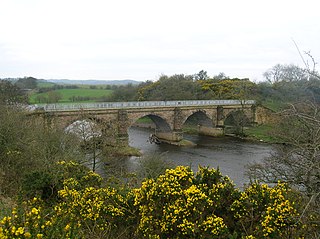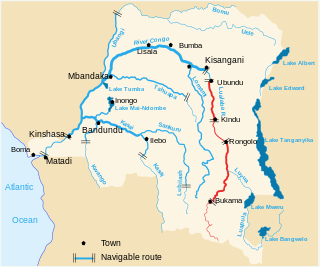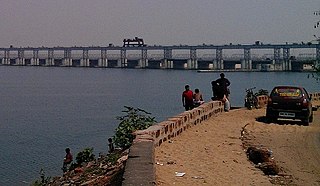
Transport in Afghanistan is limited and in the developing stage. Much of the nation's road network was built during the 1960s but left to ruin during the 1980s and 90s wars. New national highways, roads, and bridges have been rebuilt in the last decade to help increase travel as well as trade with neighboring countries. In 2008, there were about 731,607 vehicles registered inside the country.

The Congo River, formerly known as the Zaire River during the dictatorship of Mobutu Sese Seko, is the second longest river in Africa, shorter only than the Nile, as well as the second largest river in the world by discharge volume, following only the Amazon. It is also the world's deepest recorded river, with measured depths in excess of 220 m (720 ft). The Congo-Lualaba-Chambeshi River system has an overall length of 4,700 km (2,920 mi), which makes it the world's ninth-longest river. The Chambeshi is a tributary of the Lualaba River, and Lualaba is the name of the Congo River upstream of Boyoma Falls, extending for 1,800 km (1,120 mi).

A viaduct is a bridge composed of several small spans for crossing a valley, dry or wetland, or forming an overpass or flyover.

The Lualaba River flows entirely within the eastern Democratic Republic of the Congo. It is the greatest river source (headstream) of the Congo River by volume of water. The Lualaba is 1,800 kilometres (1,100 mi) long. Its headwaters are in the country's far southeastern corner near Musofi and Lubumbashi in Katanga Province, next to Zambia. The Chambeshi River is the longest river source (headstream) of the Congo.

The Luapula River is a section of Africa's second-longest river, the Congo. It is a transnational river forming for nearly all its length part of the border between Zambia and the DR Congo. It joins Lake Bangweulu to Lake Mweru and gives its name to the Luapula Province of Zambia.

The First Thai–Lao Friendship Bridge is a bridge over the Mekong, connecting Nong Khai Province and the city of Nong Khai in Thailand with Vientiane Prefecture in Laos; the city of Vientiane is approximately 20 km (12 mi) from the bridge. With a length of 1,170 meters (0.73 mi), the bridge has two 3.5 m -wide road lanes, two 1.5 m -wide footpaths and a single 1,000 mm gauge railway line in the middle, straddling the narrow central reservation.

The Lukuga River is a tributary of the Lualaba River in the Democratic Republic of the Congo (DRC) that drains Lake Tanganyika. It is unusual in that its flow varies not just seasonally but also due to longer term climate fluctuations.

Downtown Portland, the city center of Portland, Oregon, United States, is located on the west bank of the Willamette River. It is in the northeastern corner of the southwest section of the city and where most of the city's high-rise buildings are found.

The Matadi Bridge, also known as the OEBK Bridge for Organisation pour l’équipement de Banana-Kinshasa, and formerly known as Pont Maréchal in French, is a suspension bridge across the Congo River at Matadi, Democratic Republic of the Congo. It was completed in 1983 by a consortium of Japanese companies. With a main span of 520 metres (1,710 ft), it was the longest suspension bridge in Africa from its inauguration until the 2018 opening of the Maputo–Katembe bridge. The bridge crosses the Congo River at its narrowest point, just downstream from the port of Matadi. It is in fact the only road and rail crossing of the Congo River proper, the only other existing crossing being the Kongolo Bridge in Katanga which spans the Lualaba River, a tributary of the Congo.

Rail transport in the Democratic Republic of the Congo is provided by the National Railway Company of the Congo, the ONATRA and the Office of the Uele Railways.
Smolensky Metro Bridge is a steel arch bridge that spans Moskva River in Dorogomilovo District of Moscow, Russia. It is the first bridge built for the Moscow Metro in 1935–1937, designed by N.P.Polikarpov, P.K.Antonov and Yakovlev brothers. It is one of two bridges over Moskva River that are used exclusively by Metro (subway) trains, while the other Metro bridges combine road and rail.
Kongolo is a town in Tanganyika Province in the Democratic Republic of the Congo. It is located on the west bank of the Lualaba River, the largest headstream of the Congo River. It has 62,455 inhabitants.

The Tianxingzhou Yangtze River Bridge is a combined road and rail bridge across the Yangtze River in the city of Wuhan, the capital of the Hubei Province of China.

The Second Mahanadi Rail Bridge is a rail bridge over the Mahanadi near Cuttack in the Indian state of Odisha.

Kongolo Airport is an airport serving the Lualaba River city of Kongolo, Democratic Republic of the Congo.

The Dongshuimen Bridge and the Qianximen Bridge, known collectively as the Twin River Bridges, are a pair of bridges that form a road and rail connection in Chongqing, China. Consisting of two cable-stayed bridges and a tunnel across the Yuzhong peninsula, the connection opened in 2014.
This page is based on this
Wikipedia article Text is available under the
CC BY-SA 4.0 license; additional terms may apply.
Images, videos and audio are available under their respective licenses.














